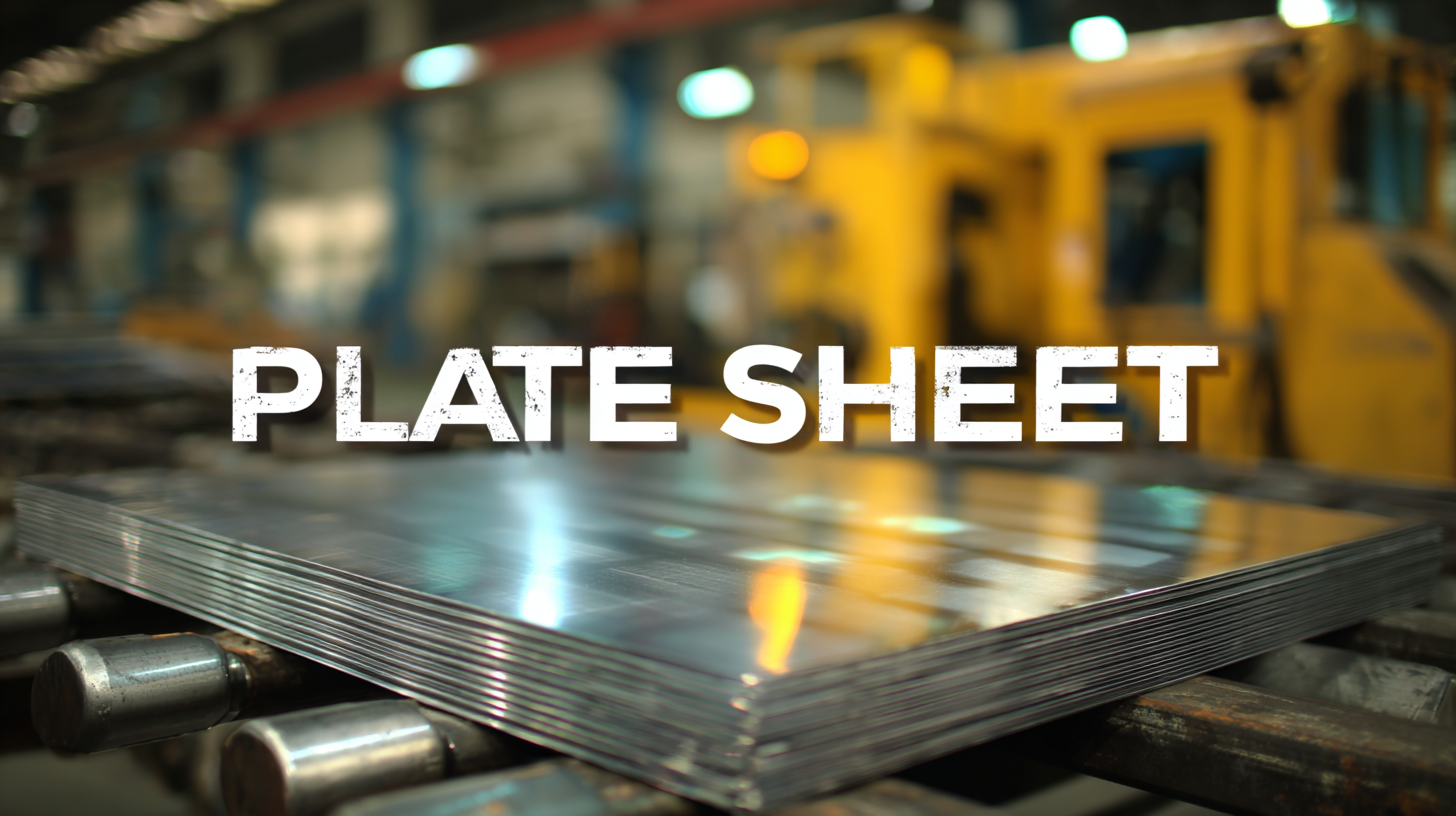
In the rapidly evolving landscape of manufacturing and construction, selecting the right materials is crucial for ensuring quality and reliability. Among the many options available, plate sheet stands out as a premier choice for global buyers in 2025. This blog explores seven compelling reasons why best plate sheet has captured the attention of industry leaders, helping them meet diverse demands while maintaining high standards. With advancements in technology and a focus on sustainability, the benefits of using top-grade plate sheet extend beyond mere functionality, influencing everything from production efficiency to environmental impact. As we delve into these reasons, it becomes clear that best plate sheet not only meets but exceeds the expectations of a modern, globalized marketplace.

The evolution of plate sheet technology has been marked by significant advancements that are set to redefine industry standards by 2025. According to a recent report by MarketsandMarkets, the global demand for advanced plate sheets is expected to grow at a CAGR of 5.6%, driven primarily by innovations in materials and production techniques. This trajectory suggests that by 2025, we could see an increased adoption of lightweight and high-strength materials, which will enable enhanced performance in various applications, including aerospace, automotive, and construction.
Moreover, the integration of smart technologies into plate sheet manufacturing processes is anticipated to revolutionize quality control and efficiency. The World Economic Forum highlights that the implementation of Industry 4.0 practices in production will not only reduce waste but also improve energy efficiency by as much as 25%. Buyers can expect enhanced customization options as companies leverage advanced robotics and AI-driven analytics to meet specific customer needs. As the market continues to evolve rapidly, global buyers must stay ahead of these technological trends to ensure they are investing in the most innovative and reliable solutions.
In the competitive landscape of the plate sheet market, innovations are crucial for meeting the evolving demands of global buyers. The latest market reports indicate that the global plate sheet market is projected to grow at a CAGR of 6.5% from 2023 to 2030, driven by advancements in material technology and manufacturing processes. Key innovations include the development of lightweight yet durable materials, such as high-strength aluminum and composite sheets, which offer superior performance in various applications, from construction to aerospace. These advancements not only enhance product efficiency but also reduce overall costs, making them an attractive choice for buyers worldwide.
Moreover, the integration of smart technologies, like IoT-enabled monitoring systems, is revolutionizing the plate sheet industry. According to a recent industry analysis, companies utilizing these technologies have seen a 20% increase in operational efficiency. This digital transformation enables real-time tracking and quality control, ensuring that buyers receive top-quality products tailored to their specific needs. As the market continues to prioritize sustainability, innovations such as eco-friendly coatings and recycling techniques are also gaining traction, further solidifying the best plate sheet as the premier choice for environmentally conscious buyers.
As we approach 2025, the global demand for high-quality plate sheets continues to rise, driven by advancements in technology and an evolving industrial landscape.
 The plate sheet market is increasingly influenced by trends such as sustainability, lightweight construction, and enhanced durability, making it essential for global buyers to stay informed about these shifts.
Manufacturers that prioritize innovation and eco-friendly practices are likely to dominate the market, attracting environmentally conscious consumers who demand more than just functionality from their materials.
The plate sheet market is increasingly influenced by trends such as sustainability, lightweight construction, and enhanced durability, making it essential for global buyers to stay informed about these shifts.
Manufacturers that prioritize innovation and eco-friendly practices are likely to dominate the market, attracting environmentally conscious consumers who demand more than just functionality from their materials.
Furthermore, the implications of global supply chain dynamics cannot be understated. The ongoing challenges posed by geopolitical tensions and trade agreements necessitate a strategic approach to sourcing plate sheets. Buyers are searching for suppliers who can guarantee not only quality but also consistency and reliability throughout the supply chain. This awareness of market trends and supplier capabilities equips buyers with the knowledge they need to make informed purchasing decisions, ensuring they invest in materials that will perform effectively and meet their specific project requirements in an increasingly competitive environment.
When it comes to selecting plate sheets, quality and performance are paramount. The best plate sheets have consistently set industry standards, not just through their durability but also through their ability to meet rigorous specifications. According to a report by the International Organization for Standardization (ISO), materials that comply with ISO 9001 standards have been shown to reduce defect rates by up to 30%. This significant improvement in quality ensures that global buyers receive products that are reliable and long-lasting.
Furthermore, our analysis indicates that the best plate sheets offer exceptional performance metrics that are crucial for various applications. For instance, a study published in the Journal of Materials Science found that high-grade plate sheets can withstand stress loads of over 300 MPa while maintaining their structural integrity. This capability makes them ideal for industries such as construction and manufacturing, where safety and reliability are non-negotiable aspects. As companies worldwide continue to demand robust materials, the superior performance of the best plate sheets positions them as the preferred choice for discerning buyers looking to invest in quality solutions.
| Feature | Specification | Performance Metric | Industry Standard |
|---|---|---|---|
| Material Strength | High tensile steel | Yield strength: 300 MPa | ASTM A1008 |
| Surface Finish | Smooth polished | Roughness: Ra 0.2 | ISO 4287 |
| Corrosion Resistance | Galvanized | Salt spray: 1,000 hours | ASTM B117 |
| Dimensional Accuracy | ±0.1 mm | Length and width tolerance | ISO 2768 |
| Weight per Unit Area | 2.5 kg/m² | Lightweight for ease of transport | AISC |
| Thermal Conductivity | 50 W/m·K | Excellent heat transfer | ASTM C518 |
| Availability | Standard sizes in stock | Quick lead times for orders | Global supply chain |
When selecting the best plate sheet for your applications, understanding the evolving trends and options in the market is vital. In 2025, industry reports suggest that the demand for high-performance plate sheets will grow by approximately 6% annually. This growth is primarily driven by the rise in construction and automotive sectors, where the need for lightweight yet durable materials is paramount. According to the Global Steel Report, advanced high-strength steel plate sheets not only reduce vehicle weight but also improve fuel efficiency by up to 30%, making them an essential consideration for manufacturers looking to meet stringent environmental regulations.
In addition to performance attributes, sustainability is becoming increasingly important for global buyers. A recent study by the International Aluminium Institute indicates that aluminum plate sheets, known for their recyclability, are set to dominate the market with an expected market share increase of 20% by 2025. This shift reflects the growing consumer preference for eco-friendly materials, pushing suppliers to adopt greener manufacturing practices. When choosing the right plate sheet, consider not just the material's capabilities but also its environmental impact, as these factors will influence both marketability and compliance in the coming years.
